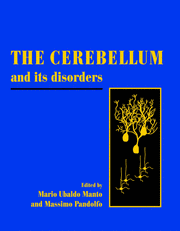Book contents
- Frontmatter
- Contents
- List of contributors
- Preface
- Acknowledgments
- Foreword by Sid Gilman
- PART I INTRODUCTION
- PART II THEORIES OF CEREBELLAR CONTROL
- PART III CLINICAL SIGNS AND PATHOPHYSIOLOGICAL CORRELATIONS
- PART IV SPORADIC DISEASES
- 10 Congenital malformations of the cerebellum and posterior fossa
- 11 Multiple system atrophy and idiopathic late-onset cerebellar ataxia
- 12 Corticobasal degeneration
- 13 Cerebellar stroke
- 14 Immune diseases
- 15 Infectious diseases: radiology and treatment of cerebellar abscesses
- 16 Other infectious diseases
- 17 Cerebellar disorders in cancer
- 18 Posterior fossa trauma
- 19 Thyroid hormone and cerebellar development
- 20 Endocrine disorders: clinical aspects
- PART V TOXIC AGENTS
- PART VI ADVANCES IN GRAFTS
- PART VII NEUROPATHOLOGY
- PART VIII DOMINANTLY INHERITED PROGRESSIVE ATAXIAS
- PART IX RECESSIVE ATAXIAS
- Index
20 - Endocrine disorders: clinical aspects
from PART IV - SPORADIC DISEASES
Published online by Cambridge University Press: 06 July 2010
- Frontmatter
- Contents
- List of contributors
- Preface
- Acknowledgments
- Foreword by Sid Gilman
- PART I INTRODUCTION
- PART II THEORIES OF CEREBELLAR CONTROL
- PART III CLINICAL SIGNS AND PATHOPHYSIOLOGICAL CORRELATIONS
- PART IV SPORADIC DISEASES
- 10 Congenital malformations of the cerebellum and posterior fossa
- 11 Multiple system atrophy and idiopathic late-onset cerebellar ataxia
- 12 Corticobasal degeneration
- 13 Cerebellar stroke
- 14 Immune diseases
- 15 Infectious diseases: radiology and treatment of cerebellar abscesses
- 16 Other infectious diseases
- 17 Cerebellar disorders in cancer
- 18 Posterior fossa trauma
- 19 Thyroid hormone and cerebellar development
- 20 Endocrine disorders: clinical aspects
- PART V TOXIC AGENTS
- PART VI ADVANCES IN GRAFTS
- PART VII NEUROPATHOLOGY
- PART VIII DOMINANTLY INHERITED PROGRESSIVE ATAXIAS
- PART IX RECESSIVE ATAXIAS
- Index
Summary
Introduction
The main endocrine cause of cerebellar ataxia is hypothyroidism. The incidence of the sporadic congenital form of hypothyroidism is about 1 per 4000 births (Delange, 1996), but the percentage of patients presenting cerebellar defi- cits associated with congenital hypothyroidism has not been determined. In adults, the reported percentages of hypothyroid patients with ataxic gait vary according to series (Kudrjavcev, 1978), varying from 0.3% to 5%.
Subclinical hypothyroidism has a high prevalence in the general population, reaching a level of 5–10% (Cooper, 1991 Wiersinga, 1995 Samuels, 1998). Elderly women are particularly at risk (Samuels, 1998). The incidence of progression to clinical hypothyroidism has been estimated to be 5–15% per year. For subclinical hyperthyroidism, the prevalence is estimated to be 0.7–6.0% (Ross, 1996). Studies on the natural history of endogenous subclinical hyperthyroidism are limited to patients presenting autonomously functioning adenomas. Between 8.8% and 18% of patients develop thyrotoxicosis over a follow-up period of six to seven years. There are no epidemiological data concerning the incidence of cerebellar ataxia in subclinical hypothyroidism and subclinical hyperthyroidism. Recently, there have been several descriptions of cerebellar ataxia associated with Hashimoto's thyroiditis, but its incidence is also undetermined, partly because assessment of the prevalence of Hashimoto's thyroiditis is diffi- cult. Indeed, laboratory signs are found in 5–11% of the general population, but are not necessarily associated with clinical signs of thyroid dysfunction (Flynn et al., 1988 Kothbauer-Margreiter et al., 1996). In addition, studies reporting this association have included only small numbers of patients.
- Type
- Chapter
- Information
- The Cerebellum and its Disorders , pp. 316 - 324Publisher: Cambridge University PressPrint publication year: 2001

